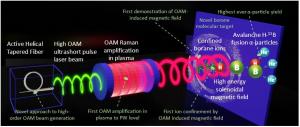
LASER VORTEX COULD BRING NUCLEAR FUSION A STEP CLOSER TO REALITY
A consortium of researchers have launched an ambitious project targeting a breakthrough in fusion generation by making the goal of nuclear fusion feasible.
PRAGUE, CZECH REPUBLIC, March 27, 2023/EINPresswire.com/ -- New concepts and advanced simulations of inertial confinement of aneutronic HB11 fusion reactions using complex Boron Hydride targets and particle acceleration will inform pioneering experiments in high-energy light/matter-interactions. Results could offer the prospect of breakthrough increases in alpha-particle yields from fusion reactions and mitigate the instabilities found in conventional fusion reactions.
The development of high-power laser sources with extreme level of orital angular momentum (OAM) offers the tantalising possibility of aneutronic fusion as a waste-free nuclear energy source and radical new configurations of particle accelerators, leading to efficient positron beam acceleration. The results will benefit society with game-changing new approaches to clean, safe energy production and significant downscaling of positron accelerators with dramatic impacts in medicine, industry and fundamental science.
Recent results from the National Ignition Facility at Lawrence Livermore National Laboratory in California have demonstrated fusion ‘energy-gain’ – where more fusion energy is output than input. Fusion development has faced numerous challenges over the past decades, including various instabilities, and, crucially, how to increase laser-fuel coupling. The challenge addressed by V4F is to enable reproduction of the same effect much more easily, reproducibly and cheaply in order to make the possibility of unlimited green-energy fusion a reality.
The Vortex-4-Fusion consortium of researchers from Finland, the Czech Republic, Germany and the UK aim to amplify laser pulses with high levels of OAM from a new design of fiber laser by several orders of magnitude via Backscattering Raman Amplification (BRA) enabling the generation of Joule level high-OAM pulses suitable for fusion reactions. The novel approach to generating twisted light aims to realise more powerful laser sources able to generate structured beams, where laser light is generated in the active medium of the fiber laser, with much higher orders of OAM than any existing approach and inducing high axial magnetic fields
An additional benefit arising from the technology being developed is that it could enable the construction of positron beam accelerators 1,000 times smaller than is currently possible. As such, the future International Linear Collider planned in Japan with a length of 31 km, could be as short as 31 m.
The capability to design an efficient positron beam system could impact the potential use in proton beam therapy treating specific types of cancer and this could be developed within 10 years.
Regina the Gumenyuk
Tampere University
regina.gumenyuk@tuni.fi
Visit us on social media:
Twitter
LinkedIn
Distribution channels: Energy Industry, Environment, Science, Technology
Legal Disclaimer:
EIN Presswire provides this news content "as is" without warranty of any kind. We do not accept any responsibility or liability for the accuracy, content, images, videos, licenses, completeness, legality, or reliability of the information contained in this article. If you have any complaints or copyright issues related to this article, kindly contact the author above.
Submit your press release

